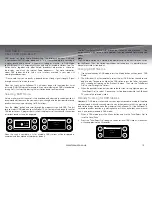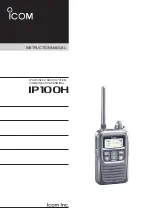
29
monitoraudio.co.uk
gLoSSary of termS
AAC -
•
Advanced Audio Coding. This is a standardised encoding system for
digital audio. Designed to be the successor of the MP3 format, AAC generally
achieves better sound quality than MP3.
AAC’s best known use is as the default audio format of Apple’s iPhone, iPod,
iTunes, and the format used for all iTunes Store audio.
DAB -
•
Digital Audio Broadcasting. This is a digital radio technology for
broadcasting radio stations, used in several countries, particularly in the uk and
europe. As of 2006, approximately 1,000 stations worldwide broadcast in the
DAB format.
The standard offers several benefits over existing analogue FM radio, such as
more stations in the same broadcast spectrum, and increased resistance to
noise, multipath, fading, and co-channel interference.
DHCP -
•
Dynamic Host Configuration Protocol (DHCP) is a network application
protocol used by devices to obtain configuration information for operation in
an Internet Protocol network. This protocol reduces system administration
workload, allowing devices to be added to the network with little or no manual
intervention.
Dynamic Host Configuration Protocol automates network parameter assignment
to network devices from one or multiple, fault-tolerant DHCP servers. even in
small networks, DHCP is useful because it can make it easy to add new machines
to the network.
Eq -
•
equaliser. This is used to change the characteristics of the sound output by
the AirStream10. The changes can included accentuated bass, treble or voices.
These are all preset curves that cannot be altered.
Frontier Silicon -
•
established in 2001 as a privately-funded fabless semiconductor
company, Frontier Silicon has rapidly become the world’s leading supplier of
innovative semiconductor, module and software solutions for digital radio and
connected audio systems.
Headquartered in Watford, on the northwest outskirts of London, Frontier Silicon
has around 120 staff, 70% engineers, with R&D centres in several locations
including Cambridge, Dublin, Shannon and Hong kong
Their multimode connected audio platforms support over 10,000 Internet radio
stations through the Frontier Silicon on-line radio portal. Innovative on-line music
services are driving forward our platforms to support more sophisticated displays
and graphical user interfaces as we move from mono to rich full colour uI’s.
IP Address -
•
An Internet Protocol address is a numerical identification that is
assigned to devices participating in a computer network utilising the Internet
Protocol for communication between its nodes. Although IP addresses are stored
as binary numbers, they are usually displayed in human-readable notations, such
as 192.168.68.1
The original designers of TCP/IP defined an IP address as a 32-bit number and
this system, is still in use today.
Media Streaming -
•
Streaming media is media that is constantly transferred
between devices contained on a network.
MP3 -
•
MP3, is a digital audio encoding format using a form of lossy data
compression. It is a common audio format for consumer audio storage, as well
as a de facto standard encoding for the transfer and playback of music on digital
audio players.
Podcast -
•
A podcast is a series of audio or video digital media files which are
distributed over the Internet, through web feeds, to portable media players and
personal computers. Though the same content may also be made available by
direct download or streaming, a podcast is distinguished from most other digital
media formats by its ability to be syndicated, subscribed to, and downloaded
automatically when new content is added. Like the term broadcast, podcast
can refer either to the series of content itself or to the method by which it is
syndicated; the latter is also called podcasting.
RDS -
•
Radio Data System, is a communications protocol standard from the
european Broadcasting union for sending small amounts of digital information
using conventional FM radio broadcasts. The RDS system standardises several
types of information transmitted, including time, track/artist info and station
identification. RDS has been standard in europe and Latin America since the
early 1990s, but less so in north America.
Radio Broadcast Data System is the official name used for the u.S. version of
RDS, though the “RDS” name seems to be at least as common in usage. The
two standards are nearly identical, with only slight differences, mainly in which
numbers are assigned to each of 31 musical and other program formats the
RBDS system can identify. RBDS was approved by the nRSC, RDS by the
eBu.
Continued...




































